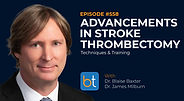BackTable / VI / Podcast / Episode #302
Treating Cerebral Aneurysms
with Dr. Aaron Bress
In this episode, neurointerventional radiologists Dr. Sabeen Dhand and Aaron Bress discuss treatment decisions and devices used in the endovascular treatment of cerebral aneurysms.
This podcast is supported by:
Be part of the conversation. Put your sponsored messaging on this episode. Learn how.

BackTable, LLC (Producer). (2023, March 17). Ep. 302 – Treating Cerebral Aneurysms [Audio podcast]. Retrieved from https://www.backtable.com
Stay Up To Date
Follow:
Subscribe:
Sign Up:
Podcast Contributors
Synopsis
Dr. Bress starts by describing the patient selection process for treatment of ruptured and unruptured aneurysms, which involves collaboration with critical care and neurosurgery teams. CTA is needed for evaluation of the quality and location of the aneurysm. He notes that it is important to check for parenchymal hemorrhage and mass effects since this warrants further consultation with neurosurgery. Generally, his practice will treat an unruptured aneurysm if it is 4mm or larger. The decision to treat also depends on the patient’s preferences and their personal evaluations of the risks regarding non-treatment as well as risks of intervention.
The major complications of interventions on unruptured aneurysms include rupture and stroke, which can range in severity. Other complications include aneurysm enlargement due to compaction of coils into the sac and introduction of thrombus into the parent vessel. To prevent this, Dr. Bress administers intraprocedural heparin and and prescribes antiplatelet agents. Dr. Bress emphasizes that complications are inevitable and it is important for IRs to develop this mindset while also taking ownership of outcomes and building rapport with patients.
Next, we discuss new endovascular technology and techniques used in the treatment of aneurysms. These include the use of flow diverters, stent or balloon-assisted coiling, and Woven EndoBridge (WEB). Each tool can be used based on different indications, and it is this creative problem solving that keeps Dr. Dhand and Dr. Bress engaged in the field.
Finally, the doctors present different pathways that trainees can use to enter the endovascular neurointerventional space. They can start from neurosurgery, neuroradiology, and neurology and go on to pursue further training.
Resources
Rapid AI:
https://www.rapidai.com/stroke
Viz.ai:
https://www.viz.ai/
For complete indications, contraindications, potential complications, warnings, precautions, and instructions, see instructions for use provided in the device. FRED X is intended for healthcare professional use only and by prescription only. Federal law restricts this device to sale by or on the order of a physician.
The Materials available on BackTable are for informational and educational purposes only and are not a substitute for the professional judgment of a healthcare professional in diagnosing and treating patients. The opinions expressed by participants of the BackTable Podcast belong solely to the participants, and do not necessarily reflect the views of BackTable.












